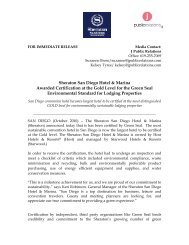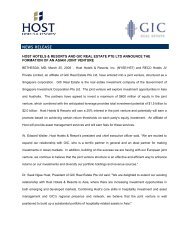Host Marriott 2004 Annual Report - Host Hotels & Resorts, Inc
Host Marriott 2004 Annual Report - Host Hotels & Resorts, Inc
Host Marriott 2004 Annual Report - Host Hotels & Resorts, Inc
You also want an ePaper? Increase the reach of your titles
YUMPU automatically turns print PDFs into web optimized ePapers that Google loves.
RevPAR at our hotels will continue to increase. Improvements in<br />
RevPAR for the first half of <strong>2004</strong> were primarily driven by<br />
increases in occupancy at our hotels. In the second half of <strong>2004</strong>,<br />
increases in RevPAR were attributable to increases in both occupancy<br />
and average room rates. We expect that demand will continue<br />
to grow and allow for additional growth in average room rates<br />
in 2005. This is a result of a number of positive trends such as<br />
strong U.S. GDP growth, low supply growth of new hotels, a continued<br />
increase in corporate transient demand and a solid group<br />
booking pace. Historically, we have seen that lodging demand in<br />
the United States correlates to GDP growth, with typically a one to<br />
two quarter lag period, especially within the luxury and upperupscale<br />
sectors of the lodging industry. Therefore, given the relatively<br />
strong U.S. GDP growth in <strong>2004</strong> and the GDP forecasts for<br />
2005, we are optimistic about improvements in lodging demand in<br />
2005. As a result of these trends, we expect our comparable hotel<br />
RevPAR to increase approximately 6.5% to 8.5% for 2005.<br />
In addition to the favorable demand trends forecast to affect<br />
the lodging industry in general, we believe we will be able to<br />
capitalize on the low supply growth trends that have existed<br />
during the past few years. Supply growth in the lodging industry<br />
and the geographic markets in which we operate may be influenced<br />
by a number of factors, including growth of the economy,<br />
interest rates, local considerations and the relatively long lead<br />
time required to build urban and resort/conference hotels. We<br />
believe that the low construction levels over the past few years,<br />
together with low expectations for additional supply growth over<br />
the next few years, will lead to an imbalance between supply and<br />
growing demand that will allow for improved RevPAR performance<br />
at our hotels.<br />
In terms of profitability measures, operating margins were<br />
relatively unchanged for the first half of <strong>2004</strong>. However, operating<br />
margins increased in the second half of <strong>2004</strong>, as the average<br />
room rate increases at our hotels began to exceed the rate of<br />
inflation for the first time since 2000, resulting in an overall<br />
increase for the full year for our comparable hotels. Operating<br />
margins continue to be affected by certain of our costs, primarily<br />
wages, benefits, utilities and sales and marketing, which<br />
increased at a rate greater than inflation. We expect these costs<br />
to continue to increase at a rate greater than inflation in the<br />
near term. As noted above, approximately 31% of our revenues<br />
are from food and beverage operations. During <strong>2004</strong>, food and<br />
beverage revenue growth at our comparable hotels was 5.7%.<br />
As the economy continues to expand in 2005, we expect to see<br />
an increase in our catering revenues, which should improve our<br />
food and beverage operating margins.<br />
We also may see improvements in RevPAR and operating<br />
margins as we continue our strategy of recycling assets. As noted<br />
below, over the past year we have been acquiring upper-upscale<br />
and luxury properties in urban and resort/conference locations,<br />
where further large-scale lodging development is limited, and<br />
selling assets in suburban, secondary and tertiary markets. The<br />
assets we have been acquiring have higher RevPAR, higher operating<br />
margins and, we believe, higher growth potential than<br />
those we have sold. Over time, this should contribute to<br />
improvements in overall RevPAR and operating margins.<br />
During <strong>2004</strong>, the average RevPAR penetration index for our<br />
comparable hotels modestly declined, but it remains at a pre-<br />
mium in relation to our competitive set. This follows a similar<br />
decline in our average RevPAR penetration index for our comparable<br />
hotels in 2003. Market share at our urban and airport<br />
hotels increased slightly in <strong>2004</strong>, reversing the prior year trend<br />
as a result of the increase in business travel; however, market<br />
share continued to decline at our suburban properties and our<br />
larger convention hotels. We believe that this decline in market<br />
share over the past two years occurred because:<br />
• our hotels generally have a higher percentage of their revenues<br />
generated by corporate group and corporate transient<br />
customers than their competitors and that business in the<br />
upper-upscale and luxury segment did not begin to significantly<br />
increase until the second half of <strong>2004</strong>;<br />
• certain of our properties overcommitted to lower-rated<br />
group business late in 2003, which has resulted in those<br />
properties being unable to take advantage of higher-rated<br />
transient business as travel increased in <strong>2004</strong>;<br />
• we have a significant number of large hotels in our portfolio,<br />
including nine convention hotels with greater than 1,000<br />
rooms, which require longer periods of time to rebuild their<br />
customer base; and<br />
• new supply in several of our markets affected our hotels.<br />
As lodging demand continues to grow and, in particular, as<br />
corporate group and corporate transient business strengthens,<br />
we believe that our hotels may regain the majority of the market<br />
share lost in 2003 and <strong>2004</strong>.<br />
While we believe the combination of improved demand<br />
trends and low supply growth trends in the lodging industry<br />
creates the possibility for improvements in our business in<br />
2005, there can be no assurances that any increases in hotel<br />
revenues or earnings at our properties will continue. The trends<br />
discussed above may not occur for any number of reasons,<br />
including:<br />
• slower than anticipated growth in the economy, business<br />
investment and employment and changes in travel patterns;<br />
and<br />
• the continued threat of additional terrorist attacks, high oil<br />
prices, airline strikes and other factors that may have an<br />
adverse impact on travel and lodging demand.<br />
All of the above, as well as the risks set forth in the section<br />
“Forward-Looking Statements” may result in lower revenues or<br />
higher operating costs and declining operating margins.<br />
MANAGEMENT’S PRIORITIES<br />
Based on forecasted operating conditions, our key management<br />
priorities over the next several years include the following:<br />
• to work with our managers to increase revenues and<br />
minimize operating costs;<br />
• to invest capital in our existing portfolio to maintain our<br />
assets and pursue repositioning/return on investment (ROI)<br />
opportunities. Potential investments at our hotels could<br />
include increasing the number of rooms, building a spa,<br />
fitness facility, convention or meeting space or upgrading<br />
the infrastructure, such as energy efficient heating and<br />
cooling systems;<br />
• to invest in opportunities to enhance the value of existing<br />
assets by converting underutilized space to alternate uses<br />
such as timeshare or condominium units;<br />
19<br />
HOST MARRIOTT <strong>2004</strong>








